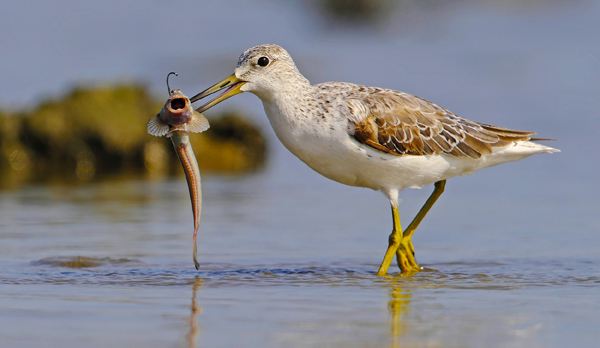Tringa guttifer
IUCN
LCBasic Information
Scientific classification
- name:Tringa guttifer
- Scientific Name:Tringa guttifer,Spotted Greenshank,Nordmann's GreenshankNordstrom's Snipe
- Outline:Wading birds
- Family:Charadriformes S.family S.Genus
Vital signs
- length:29-32cm
- Weight:125-170g
- lifetime:10-12years
Feature
The mouth is thick, slightly upturned, and the feet are short, yellow, green, or yellowish brown
Distribution and Habitat
It is distributed in Bangladesh, Brunei Darussalam, Cambodia, China, Hong Kong, India, Indonesia, Japan, Democratic People's Republic of Korea, Republic of Korea, Malaysia, Myanmar, Philippines, Singapore, Thailand and Viet Nam.
Traveler: Sri Lanka. Origin unknown: Guam.
During the breeding season, the greenest mainly inhabits swamps, ponds and wetlands in sparse larch forests, while during the non-breeding season, it inhabits coastal beaches, open and flat mud fields, estuarine bars and coastal swamps.
Appearance
The greenshank is a small wading bird with a thick, slightly upturned beak, a black tip and a yellowish-brown base. In summer, the crown of the head to the back of the neck is russet, with dark brown stripes. The back is dark brown with white spots. The waist and tail feathers are white, and the white of the waist extends down the back in a wedge, and the end of the tail feathers has a dark brown stripe, which is extremely eye-catching when flying. The lower body is white. Black circular spots on foreneck, chest and flanks. In winter, the back is grayish brown, the feather margin is white, and the lower body including the axillary and underwing coverts are pure white. The feet do not stick out behind the tail feathers when flying.
The iris is dark brown. The feet are short, yellow, green, or yellowish brown, and partially webbed between the toes.
Size measurement: Body length 290-320 mm; Rostral peak 48-58 mm; Wing 169-183 mm; Tail 62-67 mm; Tarsus 42-48 mm. (Note: male - ♂; Fema
Details
Spotted Greenshank is a small wading bird with no subspecies.

The little greenshank is a rare traveler in China. Spring is more than March-April, and autumn passes through China during migration from September to October. It is often found alone at the water's edge, on sand or mud, and foraging. They often run back and forth in shallow water with their heads down and mouths pointing downwards. It feeds mainly on small aquatic invertebrates and small fish, often wading into the water to find food at belly depth. Timid and alert, he takes off at the slightest alarm. Often head down to run back and forth, the pace appears hurried. He runs fast, he flies strong, he's fast. When flying, the agitation of the wings is not very fast, but the amplitude is large. Often standing on the crest of a low rock on the seashore waiting for the tide to ebb. When the tide goes down, search for food in the mud or sand with your mouth. Feed on small invertebrates.
The breeding season of the little greenshank is from June to August. Nest in a marsh, pond or forest edge wetland in a larch forest. The nest is mostly located in larch trees or other trees, and the height of the ground is 2-4 meters. The nest consists mainly of larch branches, mosses and lichens.
Due to habitat destruction and human hunting, the number of small green snipe has declined sharply, and the state has listed it as a key protected animal. Listed in the "China Red Book of Endangered animals birds" undetermined species
Listed on the International Union for Conservation of Nature Red List of Threatened Species (IUCN) in 2016 ver 3.1 -- (EN).
Listed in Appendix I, Appendix II and Appendix III of the Convention on International Trade in Endangered Species of Wild Fauna and Flora (CITES) 2019 edition.
Listed in China's "National Key Protected Wildlife List" (February 5, 2021).
Protect wild animals and eliminate wild meat.
Maintaining ecological balance is everyone's responsibility!








